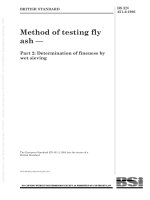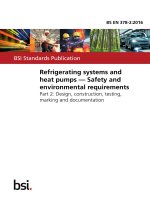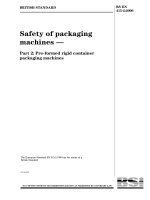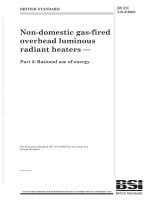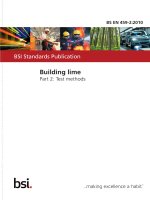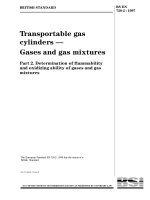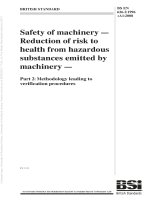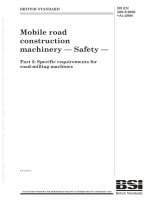Bsi bs en 00868 2 2017
Bạn đang xem bản rút gọn của tài liệu. Xem và tải ngay bản đầy đủ của tài liệu tại đây (1.89 MB, 28 trang )
BS EN 868-2:2017
BSI Standards Publication
Packaging for terminally
sterilized medical devices
Part 2: Sterilization wrap — Requirements
and test methods
BS EN 868-2:2017
BRITISH STANDARD
National foreword
This British Standard is the UK implementation of EN 868-2:2017.
It supersedes BS EN 868-2:2009 which is withdrawn.
The UK participation in its preparation was entrusted to Technical
Committee CH/198, Sterilization and Associated Equipment and
Processes.
A list of organizations represented on this committee can be
obtained on request to its secretary.
This publication does not purport to include all the necessary
provisions of a contract. Users are responsible for its correct
application.
© The British Standards Institution 2017.
Published by BSI Standards Limited 2017
ISBN 978 0 580 90656 5
ICS 11.080.30; 55.040
Compliance with a British Standard cannot confer immunity from
legal obligations.
This British Standard was published under the authority of the
Standards Policy and Strategy Committee on 28 February 2017.
Amendments/corrigenda issued since publication
Date
Text affected
BS EN 868-2:2017
EN 868-2
EUROPEAN STANDARD
NORME EUROPÉENNE
EUROPÄISCHE NORM
February 2017
ICS 11.080.30
Supersedes EN 868-2:2009
English Version
Packaging for terminally sterilized medical devices - Part
2: Sterilization wrap - Requirements and test methods
Emballages des dispositifs médicaux stérilisés au stade
terminal - Partie 2: Enveloppe de stérilisation Exigences et méthodes d'essai
Verpackungsmaterialien für in der Endverpackung zu
sterilisierende Medizinprodukte - Teil 2:
Sterilisierverpackung - Anforderungen und
Prüfverfahren
This European Standard was approved by CEN on 4 December 2016.
CEN members are bound to comply with the CEN/CENELEC Internal Regulations which stipulate the conditions for giving this
European Standard the status of a national standard without any alteration. Up-to-date lists and bibliographical references
concerning such national standards may be obtained on application to the CEN-CENELEC Management Centre or to any CEN
member.
This European Standard exists in three official versions (English, French, German). A version in any other language made by
translation under the responsibility of a CEN member into its own language and notified to the CEN-CENELEC Management
Centre has the same status as the official versions.
CEN members are the national standards bodies of Austria, Belgium, Bulgaria, Croatia, Cyprus, Czech Republic, Denmark, Estonia,
Finland, Former Yugoslav Republic of Macedonia, France, Germany, Greece, Hungary, Iceland, Ireland, Italy, Latvia, Lithuania,
Luxembourg, Malta, Netherlands, Norway, Poland, Portugal, Romania, Serbia, Slovakia, Slovenia, Spain, Sweden, Switzerland,
Turkey and United Kingdom.
EUROPEAN COMMITTEE FOR STANDARDIZATION
COMITÉ EUROPÉEN DE NORMALISATION
EUROPÄISCHES KOMITEE FÜR NORMUNG
CEN-CENELEC Management Centre: Avenue Marnix 17, B-1000 Brussels
© 2017 CEN
All rights of exploitation in any form and by any means reserved
worldwide for CEN national Members.
Ref. No. EN 868-2:2017 E
BS EN 868-2:2017
EN 868-2:2017 (E)
Contents
Page
European foreword....................................................................................................................................................... 4
Introduction .................................................................................................................................................................... 5
1
Scope .................................................................................................................................................................... 6
2
Normative references .................................................................................................................................... 6
3
Terms and definitions ................................................................................................................................... 7
4
Requirements ................................................................................................................................................... 7
5
Information to be supplied by the manufacturer ............................................................................. 11
Annex A (informative) Details of significant technical changes between this European
Standard and the previous edition ........................................................................................................ 12
Annex B (informative) Method for the determination of drape ................................................................. 13
B.1
Apparatus........................................................................................................................................................ 13
B.1.1 Softness tester ............................................................................................................................................... 13
B.1.2 Rule ................................................................................................................................................................... 13
B.2
Procedure........................................................................................................................................................ 13
B.3
Test report ...................................................................................................................................................... 13
Annex C (normative) Method for the determination of water repellency.............................................. 14
C.1
Apparatus........................................................................................................................................................ 14
C.2
Reagent ............................................................................................................................................................ 14
C.3
Procedure........................................................................................................................................................ 14
C.4
Repeatability and reproducibility.......................................................................................................... 14
C.5
Test report ...................................................................................................................................................... 15
Annex D (normative) Method for the determination of pore size ............................................................. 16
D.1
Principle .......................................................................................................................................................... 16
D.2
Test liquid ....................................................................................................................................................... 16
D.3
Apparatus........................................................................................................................................................ 16
D.4
Preparation of test specimens ................................................................................................................. 18
D.5
Procedure........................................................................................................................................................ 18
D.6
Result ................................................................................................................................................................ 19
D.6.1 Calculation and expression of results ................................................................................................... 19
D.6.2 Derivation of formula for calculation of equivalent pore radius................................................ 19
D.7
Repeatability and reproducibility.......................................................................................................... 20
D.8
Test report ...................................................................................................................................................... 20
2
BS EN 868-2:2017
EN 868-2:2017 (E)
Annex E (informative) Repeatability and reproducibility of test methods ............................................ 21
Bibliography ................................................................................................................................................................. 23
3
BS EN 868-2:2017
EN 868-2:2017 (E)
European foreword
This document (EN 868-2:2017) has been prepared by Technical Committee CEN/TC 102 “Sterilizers
and associated equipment for processing of medical devices”, the secretariat of which is held by DIN.
This European Standard shall be given the status of a national standard, either by publication of an
identical text or by endorsement, at the latest by August 2017, and conflicting national standards shall
be withdrawn at the latest by August 2017.
Attention is drawn to the possibility that some of the elements of this document may be the subject of
patent rights. CEN shall not be held responsible for identifying any or all such patent rights.
This document supersedes EN 868-2:2009.
Annex A provides details of significant technical changes between this European Standard and the
previous edition.
EN 868 consists of the following parts, under the general title Packaging for terminally sterilized medical
devices:
— Part 2: Sterilization wrap — Requirements and test methods;
— Part 3: Paper for use in the manufacture of paper bags (specified in EN 868-4) and in the manufacture
of pouches and reels (specified in EN 868-5) — Requirements and test methods;
— Part 4: Paper bags — Requirements and test methods;
— Part 5: Sealable pouches and reels of porous materials and plastic film construction — Requirements
and test methods;
— Part 6: Paper for low temperature sterilization processes — Requirements and test methods;
— Part 7: Adhesive coated paper for low temperature sterilization processes — Requirements and test
methods;
— Part 8: Re-usable sterilization containers for steam sterilizers conforming to EN 285 — Requirements
and test methods;
— Part 9: Uncoated nonwoven materials of polyolefines — Requirements and test methods;
— Part 10: Adhesive coated nonwoven materials of polyolefines — Requirements and test methods.
In addition, ISO/TC 198 “Sterilization of health care products” in collaboration with CEN/TC 102
“Sterilizers and associated equipment for processing of medical devices” has prepared the series
EN ISO 11607 “Packaging for terminally sterilized medical devices”. The EN ISO 11607- series specifies
general requirements for materials, sterile barrier systems and packaging systems (Part 1) and
validation requirements for forming, sealing and assembly processes (Part 2).
According to the CEN-CENELEC Internal Regulations, the national standards organisations of the
following countries are bound to implement this European Standard: Austria, Belgium, Bulgaria,
Croatia, Cyprus, Czech Republic, Denmark, Estonia, Finland, Former Yugoslav Republic of Macedonia,
France, Germany, Greece, Hungary, Iceland, Ireland, Italy, Latvia, Lithuania, Luxembourg, Malta,
Netherlands, Norway, Poland, Portugal, Romania, Serbia, Slovakia, Slovenia, Spain, Sweden, Switzerland,
Turkey and the United Kingdom.
4
BS EN 868-2:2017
EN 868-2:2017 (E)
Introduction
The EN ISO 11607- series consists of two parts under the general title “Packaging for terminally
sterilized medical devices”. Part 1 of this series specifies general requirements and test methods for
materials, preformed sterile barrier systems, sterile barrier systems and packaging systems that are
intended to maintain sterility of terminally sterilized medical devices to the point of use. Part 2 of this
series specifies validation requirements for forming, sealing and assembly processes.
General requirements for all types of sterile barrier systems are provided by EN ISO 11607-1.
The EN 868 series can be used to demonstrate compliance with one or more of the requirements
specified in EN ISO 11607-1.
CEN/TC 102/WG 4 also appreciates the initiatives of CEN with regard to the minimization of adverse
environmental impacts by standards. It was agreed that this subject should be given priority during the
next edition of the EN ISO 11607- series that is the basic reference for all parts of the EN 868 series.
5
BS EN 868-2:2017
EN 868-2:2017 (E)
1 Scope
This European Standard specifies test methods and values for materials for sterile barrier systems
and/or packaging systems that are intended to maintain sterility of terminally sterilized medical
devices to the point of use.
Other than the general requirements as specified in EN ISO 11607-1 and EN ISO 11607-2 this part of
EN 868 specifies materials, test methods and values that are specific to the products covered by this
European Standard.
While materials specified in 4.2.2.1 to 4.2.2.3 of this part of EN 868 are intended for single use, the
materials specified in 4.2.2.4 are intended for reuse.
2 Normative references
The following documents, in whole or in part, are normatively referenced in this document and are
indispensable for its application. For dated references, only the edition cited applies. For undated
references, the latest edition of the referenced document (including any amendments) applies.
EN 20187, Paper, board and pulps — Standard atmosphere for conditioning and testing and procedure for
monitoring the atmosphere and conditioning of samples (ISO 187)
EN 20811, Textiles — Determination of resistance to water penetration — Hydrostatic pressure test (ISO
811)
EN 29073-3, Textiles — Test methods for nonwovens — Part 3: Determination of tensile strength and
elongation (ISO 9073-3)
EN ISO 535, Paper and board — Determination of water absorptiveness — Cobb method (ISO 535)
EN ISO 536, Paper and board — Determination of grammage (ISO 536)
EN ISO 1924-2, Paper and board — Determination of tensile properties — Part 2: Constant rate of
elongation method (20 mm/min) (ISO 1924-2)
EN ISO 1974, Paper — Determination of tearing resistance — Elmendorf method (ISO 1974)
EN ISO 2758, Paper — Determination of bursting strength (ISO 2758)
EN ISO 9237, Textiles — Determination of permeability of fabrics to air (ISO 9237)
EN ISO 11607-1:2009+A1:2014, Packaging for terminally sterilized medical devices — Part 1:
Requirements for materials, sterile barrier systems and packaging systems (ISO 116071:2006+AMD1:2014)
EN ISO 13937-1, Textiles — Tear properties of fabrics — Part 1: Determination of tear force using ballistic
pendulum method (Elmendorf) (ISO 13937-1)
EN ISO 13938-1, Textiles — Bursting properties of fabrics — Part 1: Hydraulic method for determination
of bursting strength and bursting distension (ISO 13938-1)
ISO 2470-2, Paper, board and pulps — Measurement of diffuse blue reflectance factor — Part 2: Outdoor
daylight conditions (D65 brightness)
6
BS EN 868-2:2017
EN 868-2:2017 (E)
ISO 3689, Paper and board — Determination of bursting strength after immersion in water
ISO 3781, Paper and board — Determination of tensile strength after immersion in water
ISO 5636-3, Paper and board — Determination of air permeance (medium range) — Part 3: Bendtsen
method
ISO 6588-2:2012, Paper, board and pulps — Determination of pH of aqueous extracts — Part 2: Hot
extraction
ISO 8601, Data elements and interchange formats — Information interchange — Representation of dates
and times
ISO 9197, Paper, board and pulps — Determination of water-soluble chlorides
ISO 9198, Paper, board and pulp — Determination of water-soluble sulfates
3 Terms and definitions
For the purposes of this document, the terms and definitions given in EN ISO 11607-1:2009+A1:2014
apply.
4 Requirements
4.1 General
For any material, preformed sterile barrier system or sterile barrier system, the requirements of
EN ISO 11607-1 shall apply.
This part of EN 868 only introduces performance requirements and test methods that are specific to the
products covered by this part of EN 868 but does not add or modify the general requirements specified
in EN ISO 11607-1.
As such, the particular requirements in 4.2 can be used to demonstrate compliance with one or more
but not all of the requirements of EN ISO 11607-1.
NOTE 1
Compliance to EN 868–2 does not automatically mean compliance to EN ISO 11607-1.
A confirmation of compliance to EN 868-2 shall contain a statement whether EN ISO 11607-1 is
covered.
NOTE 2
When additional materials are used inside the sterile barrier system in order to ease the organization,
drying or aseptic presentation (e.g. inner wrap, container filter, indicators, packing lists, mats, instrument
organizer sets, tray liners or an additional envelope around the medical device) then other requirements,
including the determination of the acceptability of these materials during validation activities, can apply.
4.2 Performance requirements and test methods
NOTE
See Annex E for repeatability and reproducibility of the test methods: pore diameters, sulphate
content, chloride content and water repellency. For information on statement of precision and/or bias,
repeatability and reproducibility of other test methods, see EN ISO 11607-1:2009+A1:2014, Table B.1.
7
BS EN 868-2:2017
EN 868-2:2017 (E)
4.2.1 General
4.2.1.1
No colour shall leach out of the wrap. Compliance shall be tested by visual examination of a
hot aqueous extract prepared in accordance with the method given in ISO 6588-2.
4.2.1.2
The average mass of 1 m2 of the conditioned wrap when tested in accordance with
EN ISO 536 shall be within ± 5 % of the nominal value stated by the manufacturer.
4.2.1.3
The pH of an aqueous extract of the wraps shall be not less than 5 or greater than 8 when
tested in accordance with ISO 6588-2, hot extraction method.
4.2.1.4
The chloride content of the wrap, calculated as sodium chloride, shall not exceed 0,05 %
when tested in accordance with ISO 9197 using a hot extract prepared in accordance with
ISO 6588-2:2012, 7.2 except that 2 ml of potassium chloride solution is not added.
4.2.1.5
The sulphate content of the wrap, calculated as sodium sulphate, shall not exceed 0,25 %
when tested in accordance with ISO 9198, using a hot extract prepared in accordance with
ISO 6588-2:2012, 7.2 except that 2 ml of potassium chloride solution is not added.
4.2.1.6
When tested in accordance with ISO 2470-2 the material shall not exhibit an increase in D65
brightness, due to the optical brightener agents, of more than 1 %; calculated as the ratio of the D65
brightness measured with the 420 nm UV-cut-off filter in place to the D65 brightness measured without
420 nm UV-cut-off filter.
4.2.1.7
When exposed at 25 cm from a UV light source, the material shall not have per 0,01 m2 more
than five fluorescent spots, each having an axis greater than 1 mm.
NOTE
4.2.1.8
The UV light to be used is the one described as per Annex C.
NOTE
For test method, see e.g. EN ISO 9073-9 and Annex B.
The manufacturer shall provide drapeability results and associated test method on request.
4.2.2 Specific requirements
4.2.2.1 Wrap made of plain paper
4.2.2.1.1 The internal tearing resistance of the conditioned wrap shall be not less than 500 mN in
both machine and cross direction when tested in accordance with EN ISO 1974.
4.2.2.1.2 The air permeance of the conditioned wrap shall be not less than 1,7 µm/Pa ⋅ s at an air
pressure of 1,47 kPa when tested in accordance with ISO 5636-3.
4.2.2.1.3 The bursting strength of the conditioned wrap shall be not less than 110 kPa when tested in
accordance with EN ISO 2758.
4.2.2.1.4 The wet bursting strength of the wrap shall be not less than 35 kPa when tested in
accordance with ISO 3689 using an immersion time of 10 min.
4.2.2.1.5 The water repellency of the wrap shall be such that the penetration time is not less than 20 s
when tested in accordance with Annex C.
4.2.2.1.6 When tested in accordance with Annex D, the average of the pore diameters of the ten test
pieces shall be lower than or equal to 35 μm. No value shall be greater than 50 μm.
8
BS EN 868-2:2017
EN 868-2:2017 (E)
4.2.2.1.7 The tensile strength of the conditioned wrap shall be not less than 1,33 kN/m in machine
direction and not less than 0,67 kN/m in cross direction when tested in accordance with EN ISO 1924-2.
4.2.2.1.8 The wet tensile strength of the wrap shall be not less than 0,33 kN/m in machine direction
and not less than 0,27 kN/m in cross direction when tested in accordance with ISO 3781.
4.2.2.1.9 The surface absorbency of each side of the paper shall be not more than 20 g/m2 when
tested in accordance with EN ISO 535 using a 60 s exposure time (Cobb test).
4.2.2.2 Wrap made of creped paper
4.2.2.2.1
The wrap shall be creped to give increased flexibility.
4.2.2.2.2 The elongation at break of the conditioned wrap shall be not less than 10 % in the machine
direction and not less than 2 % in the cross direction when tested by measurement of the elongation in
conjunction with the test for tensile strength in accordance with EN ISO 1924-2.
4.2.2.2.3 The water repellency of the wrap shall be such that the penetration time is not less than 20 s
when tested in accordance with Annex C.
4.2.2.2.4 When tested in accordance with Annex D, the average of the pore diameters of the ten test
pieces shall be lower than or equal to 35 μm. No value shall be greater than 50 μm.
4.2.2.2.5 The tensile strength of the conditioned wrap shall be not less than 1,33 kN/m in machine
direction and not less than 0,67 kN/m in cross direction when tested in accordance with EN ISO 1924-2.
4.2.2.2.6 The wet tensile strength of the wrap shall be not less than 0,33 kN/m in machine direction
and not less than 0,27 kN/m in cross direction when tested in accordance with ISO 3781.
4.2.2.3 Wrap made of nonwoven material
NOTE
For the purpose of this specification, a nonwoven for sterile barrier systems can be described as a
bonded web made of textile and/or non-textile fibres.
4.2.2.3.1 The internal tearing resistance of the conditioned nonwoven wrap shall be not less than
750 mN in the machine direction and 1 000 mN in the cross direction when tested in accordance with
EN ISO 1974.
4.2.2.3.2 The bursting strength of the conditioned nonwoven wrap shall be not less than 130 kPa
when tested in accordance with EN ISO 2758.
4.2.2.3.3 The wet bursting strength of the nonwoven wrap shall be not less than 90 kPa when tested
in accordance with ISO 3689 using an immersion time of 10 min.
4.2.2.3.4 The elongation at break of the conditioned nonwoven wrap shall be not less than 5 % in the
machine direction and not less than 7 % in the cross direction when tested in accordance with
EN ISO 1924-2.
4.2.2.3.5 The resistance to water penetration of the nonwoven wrap shall be determined using the
hydrostatic head test based on EN 20811. Test results shall be documented.
4.2.2.3.6 The tensile strength of the conditioned nonwoven wrap shall be not less than 1,00 kN/m in
machine direction and not less than 0,65 kN/m in cross direction when tested in accordance with
EN ISO 1924-2.
9
BS EN 868-2:2017
EN 868-2:2017 (E)
4.2.2.3.7 The wet tensile strength of the nonwoven wrap shall be not less than 0,75 kN/m in machine
direction and not less than 0,50 kN/m in cross direction when tested in accordance with ISO 3781.
4.2.2.4 Wrap made of woven textile material
4.2.2.4.1 When the woven textile material is to be used to manufacture packaging intended to be
irradiation sterilized only, it is not necessary for it to be permeable to air, so 4.2.2.4.6 need not to apply.
4.2.2.4.2 Requirements for the processing of reusable fabrics as given in EN ISO 11607-1:2009, 5.1.11
and 5.1.12 apply and shall include the means to quantify and control the number of processing cycles.
4.2.2.4.3 The tensile strength, dry and wet, of the wrap shall be not less than 300 N in the warp and
weft directions when tested in accordance with strip method of EN 29073-3.
4.2.2.4.4 The tear strength, dry and wet, of the wrap shall be not less than 6 N in the warp and weft
directions when tested in accordance with EN ISO 13937-1. The samples for the “wet” test shall be
prepared according to EN 29073-3.
4.2.2.4.5 The bursting strength “dry” and “wet” of the wraps shall not be less than 100 kPa when
tested in accordance with EN ISO 13938-1. The preparation of samples for wet state testing shall be
performed according to EN 29073-3.
4.2.2.4.6 The air permeability of the wrap shall be not more than 20 mm/s when tested in accordance
with EN ISO 9237.
4.2.2.4.7 The resistance to water penetration of the woven textile material shall be determined using
the hydrostatic head test based on EN 20811. Test conditions and test results shall be documented.
4.3 Marking
4.3.1 Transport packaging
The transport packaging shall be legibly and durably marked with the following information:
a) reference, stock or catalogue number;
b) quantity;
c) name/company and address of the manufacturer; address shall include: street/road,
number/house/floor, postal code, city, state/region and country;
d) name and address of authorized representative within the European Community in the case where
the manufacturer does not have a registered place of business in the community; address shall
include: street/road, number/house/floor, postal code city, state/region and country;
e) date of manufacture in accordance with ISO 8601;
f)
lot number 1);
g) nominal sheet size or nominal width of rolls in millimetres and length in metres;
h) the recommended storage conditions;
1) A reference number in order to trace the manufacturing history of the product.
10
BS EN 868-2:2017
EN 868-2:2017 (E)
i)
whether sterilization wrap is intended for single use only.
NOTE 1
Regulatory requirements apply to marking and can change in the future, e.g. Unique Device
Identification (UDI).
NOTE 2
Symbols for marking can be used see EN ISO 15223-1.
4.3.2 Inner package
The inner package with sheets or inner label with reels shall be legibly and durably marked with the
information a), b), e), f) and g) according to 4.3.1.
5 Information to be supplied by the manufacturer
The following information should be supplied in addition to EN ISO 11607-1:2009, Clause 7:
a) recommendations for particular applications of sterilization wrap (e.g. sterile barrier system,
transport packaging, packaging system);
b) the nature and extent of any identified risks associated with the use of the packaging material
and/or system;
c) any information pertinent to the packaged medical device as may be required (see EN 1041).
NOTE
For requirements on information to be provided by the manufacturer national or regional legislation
can apply, see in particular Directive 93/42/EEC, Annex I, Section 13 [10].
11
BS EN 868-2:2017
EN 868-2:2017 (E)
Annex A
(informative)
Details of significant technical changes between this European Standard
and the previous edition
Changes between this European Standard and EN 868-2:2009 are the following:
a) changes in order to align this European Standard with the EN ISO 11607 series, in particular by:
1) adopting terms and definitions of EN ISO 11607 series without additional elements, i.e. deleting
“sterile field” and “surgical drape” which are covered by the EN 13795 series;
2) elucidating the requirements given by EN ISO 11607-1 as general requirements for this
standard;
3) formulating the significance and limits of the requirements of this standard with respect to the
requirements given by EN ISO 11607-1;
4) linking the test methods with regard to information on statement of precision and bias,
repeatability and reproducibility to EN ISO 11607-1:2009+A1:2014, Table B.1;
b) the test method on fluorescence is in accordance with ISO 2470-2. The test method according
Annex B has been deleted;
c) updating of the following test methods by a statement of repeatability and reproducibility:
1) method for the determination of water repellency as per Annex C;
2) method for the determination of pore size as per Annex D;
d) providing of informative data for repeatability and reproducibility of the following test methods as
per Annex E:
1) method for the determination of water repellency as per Annex C;
2) method for the determination of pore size as per Annex D;
3) chloride content;
4) sulphate content;
e) updating of the bibliography.
NOTE
12
This list is not exhaustive.
BS EN 868-2:2017
EN 868-2:2017 (E)
Annex B
(informative)
Method for the determination of drape
B.1 Apparatus
B.1.1 Softness tester
Softness tester comprising a clamp formed by a pair of flat jaws or rollers, designed to grip the end of a
25 mm wide strip of paper along a horizontal axis at right angles to its length, and mounted on a spindle
to enable the clamped end of the strip to be rotated about the spindle axis.
The edges of the clamping surfaces shall be coincident and means provided for indicating when the
clamp has rotated through 90° from any initial position.
B.1.2 Rule
Rule, graduated in millimetres.
B.2 Procedure
Condition the specimen at (23 ± 1) °C and (50 ± 2) % relative humidity for not less than 24 h. Cut 10 test
pieces, each 25 mm in width and 200 mm in length, five with the length in the machine direction of the
sample and five with the length in the cross direction.
Level the machine so that the axis of the clamping edges is horizontal and place the end of the test piece
between them. Arrange the protruding length such that on rotating the spindle clockwise at a speed of
1 r/min (15 s for a 90° turn) with the strip to the left, the strip falls through the vertical to the right and
on rotating the spindle counter clockwise, the strip does not fall back to the left when turned through
90° from that point.
Reduce the protruding length until a rotation of (90 ± 2)° clockwise and counter clockwise causes the
end of the strip to fall from one side to the other.
Measure the effective protruding length (critical length) from the line where the edges of the jaws or
rollers grip the test piece to the end of the strip.
B.3 Test report
The test report shall include the following information:
a) the mean critical length (in mm) for both machine and cross directions of the paper;
b) on request, the identification of the product under test, the identification of the test-house and the
date;
c) the normative reference of the test method.
13
BS EN 868-2:2017
EN 868-2:2017 (E)
Annex C
(normative)
Method for the determination of water repellency
C.1 Apparatus
C.1.1
C.1.2
An ultraviolet light source and light meter with a range of wavelength of 315 nm to 390 nm.
Flat dish, approximately 200 mm x 150 mm x 15 mm.
C.1.3
Desiccator.
C.1.4
Stopwatch.
C.1.5 Powder dispenser, with a sieve of nominal aperture size between 0,125 mm and 0,150 mm at
one end and closed at the other.
C.2 Reagent
Dry indicator powder prepared as described below.
Grind 20 g of sucrose in a mortar and pass through a sieve of nominal aperture size 0,063 mm to
0,075 mm. Dry the sieved sucrose in a desiccator over silica gel or in an oven at 105 °C to 110 °C. Mix
10 g of the dry sucrose with 10 mg of sodium fluorescein and pass the mixture 5 times through a sieve
of nominal aperture size 0,063 mm to 0,075 mm and finally transfer the dry indicator powder to the
powder dispenser.
The dry indicator powder in the powder dispenser should be stored either in a desiccator or in an oven
at 105 °C to 110 °C.
C.3 Procedure
Take 10 test pieces of conditioned paper, each of size 60 mm x 60 mm. Separate the samples into two
groups of five, one group with the 'wire-side' uppermost and the other with the 'top-side' uppermost.
For each sample make two folds, each 10 mm high at right angles along two edges. Fill the flat dish with
purified water at the conditioning temperature to a depth of 10 mm. Switch on the UV lamp and allow it
to develop full output and adjust the distance of the lamp so that the irradiance at the level of the water
in the dish is (300 ± 20) µW/cm2. Sprinkle the upper surface of a test piece thinly with indicator powder
from the dispenser. Float the test piece on the water under the UV light source and note the time taken
for a general fluorescence to appear. Repeat the procedure with the remaining nine test pieces.
The water repellency of the paper is considerably influenced by the temperature of the water which
shall be maintained within the specified limits (23 ± 1) °C.
C.4 Repeatability and reproducibility
See Annex E for repeatability and reproducibility of the test method.
14
BS EN 868-2:2017
EN 868-2:2017 (E)
C.5 Test report
The test report shall include the following information:
a) the mean penetration time in seconds for each side of the paper;
b) on request, the identification of the product under test, the identification of the test-house and the
date;
c) the normative reference of the test method.
15
BS EN 868-2:2017
EN 868-2:2017 (E)
Annex D
(normative)
Method for the determination of pore size
D.1 Principle
The pressure required to force air bubbles through the interstices of a material, wetted by a liquid and
having a film of the same liquid applied to its upper surface, is observed. This pressure, together with
the known surface tension of the liquid, is used to estimate the size of the interstices in the material.
D.2 Test liquid
The test liquid used should allow the paper to be wetted completely, have low solvent power for
proofing materials, cause no swelling of the fibres, have constancy of surface tension, non-toxicity, low
flammability, freedom from foaming, and moderate cost.
NOTE
Ethanol R has been found to be suitable.
D.3 Apparatus
D.3.1 The apparatus is shown diagrammatically in Figure D.1. The principal parts are as follows:
a) the testing head “1”: a cylindrical vessel of an appropriate material (e.g. brass) over which the
specimen “a” can be clamped by a clamping ring “b” and screw “c”. It is fitted with a synthetic
rubber gasket “d” of 50 mm internal diameter to make a seal against the specimen;
b) pressure measuring device;
c) a stop-valve which serves to direct air to the testing head;
d) a variable flow valve set to give the required rate of rise of pressure in “1”;
e) a stop-valve which directs air to the pressure measuring device;
f)
air reservoir of about 2,5 l capacity connected to “1”; this ensures that the rate of flow of air
necessary to maintain the required rise of pressure is so large that the loss of air through the
material when bubbling begins will not reduce the rate of rise of pressure;
g) the air supply.
D.3.2 Using the apparatus shown in Figure D.1 the test is conducted as follows:
Turn on the air supply. Open valve “3” to direct air to the test head via reservoir “6”, and adjust valve “4”
to give the required rate of pressure rise. Leave stop-valve “5” open during testing. When the first
bubble appears in the test material, “5” is closed to allow the pressure reached to be read from the
measuring device “2”.
16
BS EN 868-2:2017
EN 868-2:2017 (E)
Key
1 testing head
2 pressure measuring device
3, 5 stop valve
4 variable blow valve set
6 air reservoir
7 air supply
a
b
c
d
specimen
clamping ring
screw
rubber gasket
Figure D.1 —Diagrammatic representation of the apparatus for the determination of the pore
size
D.3.3 Apparatus for measurement of the equivalent pore size, having the following characteristics:
a) Means shall be provided for clamping the specimen of material in such a manner that:
1) it is horizontal;
2) a circular area of the material 50 mm in diameter will be subjected to steadily increasing air
pressure on the lower face;
3) no leakage of the test liquid occurs during the test period;
4) the specimen does not slip in the clamps.
NOTE 1
The clamps need to be faced with resilient material which is resistant to the test liquid. With some
forms of apparatus, it has been found that the correct conditions of clamping can be attained if the clamps are
faced with a suitable grade of synthetic rubber.
b) The rate of increase in air pressure shall be 2 kPa/min to 2,5 kPa/min (200 mm head of water per
minute to 250 mm head of water per minute). 2)
2) 1 mm head of water = 9,80655 Pa.
17
BS EN 868-2:2017
EN 868-2:2017 (E)
c) A pressure measuring device connected to the test head shall be calibrated in kilopascals (or
millimetres head of water).
d) The pressure measuring device shall have a suitable range.
NOTE 2
A pressure measuring device which provides for pressure up to 6 kPa (600 mm head of water) is
suitable for most materials. A pressure measuring device providing pressures of up to 10 kPa (1 m head of water)
is used for measurements on close materials, e.g. ventiles, clean room overalls, theatre clothing and drapes.
D.4 Preparation of test specimens
After receipt, handle the material as little as possible and do not sharply fold, iron or treat in any way
other than by conditioning. Cut specimens from the material in shape convenient for handling and
clamping. Take the test specimens from different places in the material, avoiding any creases, so that
they represent the material as fully as possible.
NOTE
For most types of apparatus, it is convenient to cut specimens from the material in the form of
75 mm x 75 mm squares.
Unless otherwise stipulated, test 10 specimens from any sample of material submitted.
D.5 Procedure
D.5.1 Conduct the test in the standard atmosphere for testing specified in EN 20187.
D.5.2 Determine the surface tension of the test liquid by any convenient method to the nearest
0,5 mN/m.
NOTE
Within the range of the standard atmosphere, the surface tension of Ethanol R usually lies between
22 mN/m and 24 mN/m, with a temperature coefficient of - 0,005 mN/(m ⋅ K). The Wilhelmy stalagmometer,
single and double capillary methods have all been found satisfactory for measuring surface tension.
D.5.3 Soak the conditioned specimen under about 15 mm (depth) of the test liquid in a glass dish.
After soaking for a minimum period of 3 min remove the specimen with forceps and clamp it on the
testing head. Pour a few millilitres of the test liquid onto the surface of the material; pour just sufficient
to cover the material completely after it has bulged slightly under the pressure exerted on the
underside during the test. Record the temperature of the test liquid at this stage.
NOTE
Very porous material, if relevant, can be more easily tested if the air pressure is allowed to increase on
the underside of the specimen and bulge the specimen before the test liquid is poured on to cover the surface of
the material completely.
D.5.4 Under increasing air pressure, bubbles appear at different places over the upper surface;
observe the specimen continuously whilst the pressure is increasing and record, to the nearest
millimetre, the pressure at which the first bubble appears on the upper surface.
D.5.5 Test further specimens until the requisite number of results is obtained.
18
BS EN 868-2:2017
EN 868-2:2017 (E)
D.6 Result
D.6.1 Calculation and expression of results
Calculate the equivalent pore radius r in micrometres for each specimen by means of the formula:
r = 2T ⋅ 10 6 / ρ ⋅ p ⋅ g
or simplified
=
r 204 ⋅ T / p
where
T
g
ρ
p
(D.1)
(D.2)
is the surface tension of the test liquid at the temperature of the test, in mN/m;
is the acceleration due to gravity, in mm/s2;
is the density of water at the temperature of the test, in mg/mm3;
is the bubble pressure, in millimetres head of water.
Calculate the mean pore radius and express the result as pore diameter.
NOTE 1
The error introduced by taking ρ = 1 mg/mm3 for the relative density of water at the temperature of
the standard atmosphere for testing is small compared with the variability of the test results.
NOTE 2
Similarly, although g is known to vary about 0,5 % from place to place, the error introduced by
assuming a constant value of 9 810 mm/s2 is small compared with the variability of the test.
D.6.2 Derivation of formula for calculation of equivalent pore radius
For a cylindrical tube, the pressure p in Pascals, necessary to force liquid through is given by the
following formula:
p=
where
T
Q
r
2T cos Q
r
(D.3)
is the surface tension of liquid, in N/m;
is the contact angle at liquid-solid-air interface, in degrees;
is the radius of tube, in metres.
This is the Laplace formula (see [8]).
The contact angle is very difficult to measure and therefore a liquid is chosen which completely wets the
material, thus cos Q = 1 and the formula becomes:
p=
2T
r
This formula is the same as the simplified formula given in D.6.1.
(D.4)
The pressure is normally measured in millimetres head of water, because either a water manometer is
used, or the pressure measuring device is calibrated in millimetres head of water.
19
BS EN 868-2:2017
EN 868-2:2017 (E)
Thus
p = pb ⋅ ρ ⋅ g
where
pb
ρ
g
(D.5)
is the head of water, in millimetres head of water;
is the density of water, in mg/mm3;
is the acceleration due to gravity, in mm/s2.
D.7 Repeatability and reproducibility
See Annex E for repeatability and reproducibility of the test method.
D.8 Test report
The test report shall include the following information:
a) the equivalent pore diameter in micrometres for each specimen and the mean pore diameter in
micrometres for the sample;
b) details of any deviation from the specified procedure;
c) on request, the identification of the product under test, the identification of the test-house and the
date;
d) the normative reference of the test method.
20
BS EN 868-2:2017
EN 868-2:2017 (E)
Annex E
(informative)
Repeatability and reproducibility of test methods
The precision of the following test methods have been assessed by a Round Robin Test protocol in 2010
and 2011, conducting a precision experiment as described in ISO 5725-2:
— pore size;
— water repellency;
— chloride content;
— sulfate content.
Table E.1 summarizes core conditions of interlaboratory testing. Table E.2 summarizes the significance
of results.
Table E.1 — Test matrix
Pore size
Water
repellency
Chloride
content
Sulfate
content
Number of
Laboratories
Number of
test runs
Replication
Number of
sample materials
7
9
10
4
3
16
10
3
3
7
2
4
3
7
2
4
Type of
materials
Plain paper,
creped paper
Fine creped
paper, Plain
paper, creped
paper
Plain paper
Plain paper
21
BS EN 868-2:2017
EN 868-2:2017 (E)
Table E.2 — Precision of test methods - Significance of results
Repeatability, sr a
Test
Pore size
Water
repellency
Chloride
content
Sulfate
content
a
Relative
to mean
results
Expressed
as %
specification
limit
Relative
to mean
result
Expressed
as %
specification
value
0,084m
+2,91
14,2
0,186m
+0,00
26,6
Units
EN 868-2
specification
µm
< 50
0,069m +
0,98
8,9
Not > 0,05
0,002
4,0
s
%
%
s = standard deviation
Not < 20
Not > 0,25
Reproducibility, sR a
0,032m
+0,84
0,01
7,4
0,120m –
0,01
4,0
0,183m +
0,01
11,9
23,2
NOTE
Table E.2 has been adopted from the publication accordingly. Detailed information concerning the
assessment, i.e. objective, methods, results, analysis and discussion, conclusions and recommendations, are
published (see [9]).
22
BS EN 868-2:2017
EN 868-2:2017 (E)
Bibliography
[1]
[2]
EN 1041, Information supplied by the manufacturer of medical devices
EN 1149–1, Protective clothing - Electrostatic properties - Part 1: Test method for measurement of
surface resistivity
[3]
EN 13795, Surgical drapes, gowns and clean air suits, used as medical devices for patients, clinical
staff and equipment — General requirements for manufacturers, processors and products, test
methods, performance requirements and performance levels
[4]
EN ISO 9073-9, Textiles - Test methods for nonwovens - Part 9: Determination of drapability
including drape coefficient (ISO 9073-9)
[5]
[6]
EN ISO 11607-2, Packaging for terminally sterilized medical devices - Part 2: Validation
requirements for forming, sealing and assembly processes (ISO 11607-2)
EN ISO 15223-1, Medical devices - Symbols to be used with medical device labels, labelling and
information to be supplied - Part 1: General requirements (ISO 15223-1)
[7]
ISO 5725-2, Accuracy (trueness and precision) of measurement methods and results — Part 2:
Basic method for the determination of repeatability and reproducibility of a standard measurement
method
[8]
ADAMSON. A. W., Physical chemistry of surfaces, New York, J. Wiley, 1976
[9]
[10]
BERRY C.W., HARDING L. Validation of Test Methods for Characterizing and Specifying Materials
Used in the Construction of Sterilization Packaging. Packag. Technol. Sci. 2012
Council Directive 93/42/EEC of 14 June 1993 concerning medical devices
23

